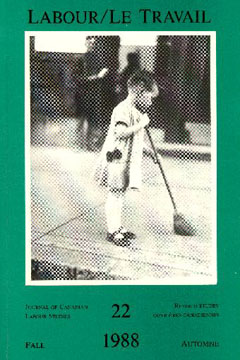Abstract
The amalgamated mine workers of Nova Scotia (AM W) was a communist led union of coal miners that broke away from the established United Mine Workers of America (UMW) in the early depression years, at a time when only communists called for trade union militance. The new union adopted principles of extreme rank-and-file democracy and radical resistance to company demands for wage cuts. It held the allegiance of the majority of miners in the province for several years, but its rival, the UMW, was supported by the coal company and the government. Moreover, the AMW never carried out its threats of a district strike to win recognition. After several years of the dual union situation, the miners saw the necessity of unity in confrontations with the company. In addition, the UMW was resurgent in the United States and had begun to take a more militant stance. Finally, changes in the policy of the Communist Party caused it to press for reunification. In rejoining the UMW, however, the miners were obliged to surrender many of their aspirations for district autonomy and inner-union democracy.
Resume
Les mineurs amalgammes de Nouelle-Ecosse (Amalgamated Miners of Nova Scotia/AMW), un syndicat de mineurs de charbon dirigé par les communistes, se sépara des Mineurs Unis d'Amérique (United Mine Workers of America/UMW) au début de la dépression des années trente alors que seuls les communistes persistaient toujours dans le militantisme syndical. Le nouveau syndicat de mineurs adopta une très grande démocratie par la base et opposa une résistance radicale à la compagnie qui voulait couper les salaires. Pendant plusieurs annes, il s'assura l'allégeance de la majorité des mineurs de la province mais son rival, l'UM W, obtint l'appui de la compagnie minière et du gouvernement. Malgré son radicalisme, l'AMW ne déclencha jamais une grève de tout le district pour obtenir la reconnaissance du syndicat. Après plusieurs années de rivalités syndicales, les mineurs virent l'importance de s'unir pour confronter la compagnie. Juste à cette époque, Γ UMW remontait la côte aux Etats-Unis et commençait à adopter un plus grand militantisme. D'autre part, des changements dans la politique du Parti communiste l'amenèrent à promouvoir une réunification syndicale. En s'affiliant aux Mineurs Unis (UMW), cependant, les mineurs durent abdiquer plusieurs de leurs revendications concernant l'autonomie du district et la démocratie syndicale.
